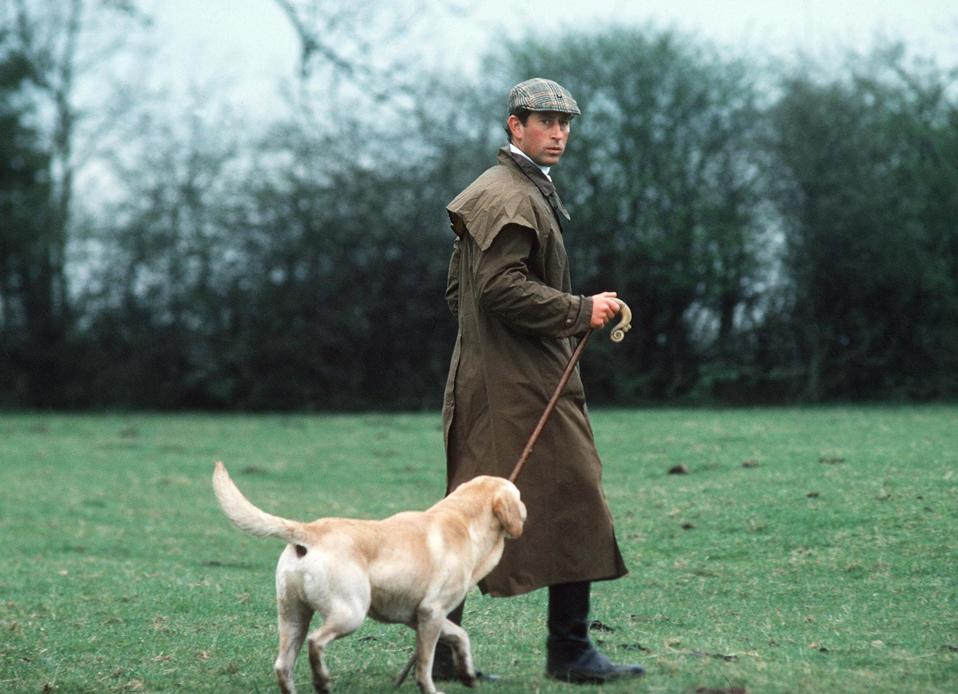With winter fast approaching, many men are reaching for their go-to cold-weather essential. Once relegated to aristocratic hunting weekends and repurposed in recent years by menswear brands, the waxed jacket has begun to outpace alternative outerwear options. Easy to wear, effortlessly stylish and prone to patina, a waxed jacket is the Anglophile’s answer to the ever-trendy leather jacket.
A Brief History Of An Icon
The story of the waxed jacket begins at sea. In the 15th century, Scottish and English sailors coated linen and cotton sails with fish oil or linseed oil to make them more weatherproof. Those same techniques were soon applied to outerwear, resulting in durable oilskins that protected fishermen and mariners from the elements.
By the late 19th century, industrial advances allowed for paraffin-wax coating—a lighter, less odorous and longer-lasting method of waterproofing. Among the first to adopt this process was Barbour, founded in 1894 in South Shields, England. Originally a supplier of oilskin garments to dockworkers and sailors, Barbour refined the waxed jacket into a country and sporting essential. The brand’s Bedale and Beaufort models, introduced in the 1980s, became enduring icons—crafted from thornproof waxed cotton and featuring corduroy collars, storm flaps and tartan linings.
Other British brands followed suit. Belstaff, established in 1924, developed its own waxed cotton jackets for motorcyclists and aviators, offering a more technical, protective approach to outerwear. Over time, what began as strictly utilitarian gear evolved into a symbol of rugged British style and now defines a new generation of menswear enthusiasts who are interested in something outside of the standard options in style today.
Styling A Waxed Jacket
The waxed jacket’s enduring relevance owes much to its adaptability. The matte, structured fabric lends an understated elegance that transitions easily between rural and urban wardrobes. For casual dressing, it’s easy enough to throw on a waxed jacket and not feel the need to dress it up in any way, making it easy to pair with a simple jumper to a flannel shirt. For more formal occasions, wearing a beat-up vintage Beadale, for example, has a certain charm of its own, showing the interplay between town and country quite handsomely.
Part of the waxed jacket’s success is due to its traditional coloring, such as black, green, blue and brown. This neutrality means it can easily fit into one’s wardrobe without much thinking, making for a subtle upgrade to one’s ratty old puffer jacket that’s seen better days. Withthat being said, Barbour’s list of collaborations, most recently with Paul Smith, have shown that the classic style of the jacket’s cut itself allows for a bit of leeway in colorways, including the unconventional, but still perfectly neutral, Grape-colored option.
Fit, too, is equally crucial. The traditional standard is for the jacket to be oversized, sometimes by up to two jacket sizes. This is how you’ll see many members of the British Royal Family, for example, wear their own waxed jackets. This allows for a bit of room when moving around, as well as for a chunky knit underneath. But if wearing for style over sport, a bit of room is recommended, but styles like Barbour’s Ashby are a bit trimmer, keeping things a bit more cosmopolitan than countryside.
Beyond Barbour: Modern Alternatives
While Barbour remains the benchmark for waxed jackets, there are many competitive alternatives on the market to match one’s individual style, budget and tastes. A close competitor to Barbour is Belstaff, a similarly known brand whose heritage began in the motorcycle sporting industry versus a more posh hunting weekend. One can still see remnants of the brand’s history in styles such as the belted Trialmaster jacket. Similarly, Drake’s Coverall Jacket keeps all the trademarks of the classic style, but in a more vibrant kelly green for those who aren’t afraid of a little color.
For those looking for an alternative style altogether, while still constructed from a waxed cotton, Flint and Tinder’s waxed Harrington-style jacket has been producing an array of options that have been garnering positive attention, most notably by GQ, in which writer Leon Hedgepeth notes this particular option is, “ready to play rough as the weather gets ugly, but doesn’t lose the gentleman’s cool.” Similarly, Taylor Stitch’s insulated bomber, coated in a dry wax, and Tecovas Buckaroo waxed trucker jacket both prove that thinking outside the box by applying a waxed coating to a variety of jacket types can sometimes have surprising–and stylish–results.
The Ease Of Maintenance
A waxed jacket’s patina is something of a double-edged sword. While many wearers and fans of this particular style show the wear as something of a badge of honor, it can also scare some potential buyers off due to the perceived complexity in maintenance. Fortunately, restoring it is quite simple, and at-home rewaxing kits are widely available, taking the guesswork out of the process entirely. In fact, many longtime fans say that the waxing process becomes something of a yearly ritual, helping to build a connection one has to his clothing. Similar to rewinding a mechanical watch or maintaining a vintage car, part of the appeal is having a manual, physical connection, helping to ensure its longevity.
Never fear, though, if an at-home solution isn’t for you, larger heritage brands like Barbour and Belstaff provide repair and waxing services. In fact, a repaired Beaufort with a new patch of waxed cotton sewn on a sleeve has something of a rugged cachet within menswear circles, especially for those who appreciate the garment as something of an heirloom versus a trend.

